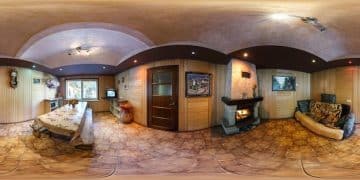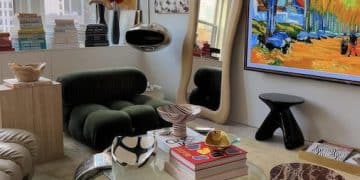How to Choose the Right Lighting for Every Room in Your Home
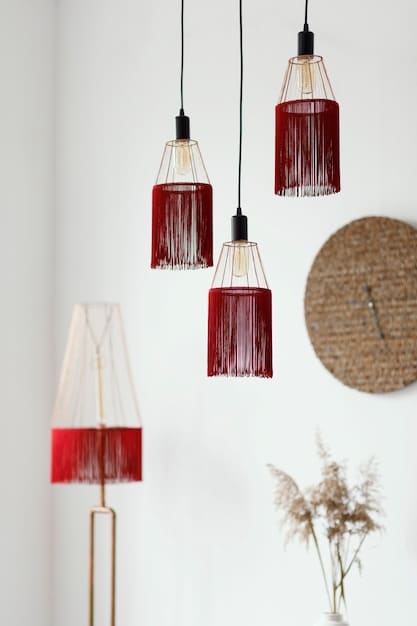
Choosing the right lighting for your home involves understanding the purpose of each room, the types of lighting available, and how they work together to create the desired ambiance and functionality.
Are you struggling to find the perfect lighting for your home? How to choose the right lighting for every room in your home can feel overwhelming, but with a little guidance, you can transform your space into a well-lit and inviting haven.
Understanding the Basics of Home Lighting
Before diving into specific rooms, it’s important to grasp the fundamental types of lighting and how they work together. This understanding will help you create a layered lighting scheme that is both functional and aesthetically pleasing.
Types of Lighting
There are three primary types of lighting: ambient, task, and accent. Each serves a different purpose and contributes to the overall lighting design.
- Ambient Lighting: Provides overall illumination to a room. It’s the base layer of light, often achieved through ceiling fixtures or recessed lighting.
- Task Lighting: Focuses light on a specific area for tasks like reading, cooking, or working. Table lamps, pendant lights, and under-cabinet lights are common choices.
- Accent Lighting: Highlights architectural features, artwork, or decorative items. Track lighting, spotlights, and wall sconces are often used for this purpose.
By combining these three types of lighting, you can create a space that is both functional and visually appealing. Consider the specific needs of each room when planning your lighting scheme.
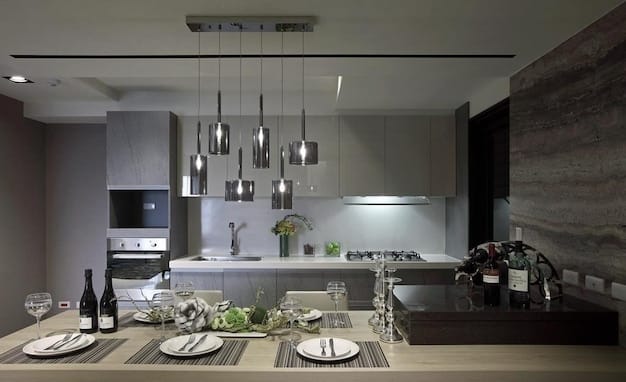
Choosing the right combination is essential for creating a comfortable and inviting atmosphere. Think about how you use the space and what activities take place there.
Lighting the Living Room: Comfort and Ambiance
The living room is often a multi-purpose space, used for relaxing, entertaining, and sometimes even working. Therefore, your lighting should be flexible and adaptable to different activities.
Layering Light in the Living Room
Begin with ambient lighting, such as recessed lighting or a stylish ceiling fixture. Add task lighting with table lamps or floor lamps near seating areas for reading or other activities. Finally, incorporate accent lighting to highlight artwork or architectural details.
Consider using a dimmer switch for your ambient lighting to adjust the brightness depending on the mood. This allows you to create a cozy and relaxing atmosphere or a brighter space for entertaining.
The key is to create a balanced lighting scheme that meets your needs and enhances the overall ambiance of the room.
- Choose Warm Light Bulbs: Create a cozy and inviting atmosphere with bulbs that emit a warm, soft light.
- Add a Statement Lamp: A unique floor lamp can serve as both a functional light source and a decorative element.
- Highlight Focal Points: Use accent lighting to draw attention to artwork, bookshelves, or other interesting features.
A well-lit living room should be both functional and inviting. By layering different types of lighting and considering the specific needs of the space, you can create a comfortable and stylish environment.
Illuminating the Kitchen: Functionality and Style
The kitchen is a highly functional space that requires bright and focused lighting. Proper lighting is essential for safety and efficiency when preparing meals and cleaning up.
Essential Kitchen Lighting Tips
Start with bright ambient lighting, such as recessed lighting or a flush-mount fixture. Add task lighting with under-cabinet lights to illuminate countertops and work surfaces. Pendant lights over the island or breakfast bar can provide both task lighting and a decorative touch.
Ensure that your lighting is evenly distributed to avoid shadows and dark spots. Consider using LED bulbs for energy efficiency and long-lasting performance.
The goal is to create a well-lit and functional space that is also aesthetically pleasing.
Consider the color temperature of your light bulbs. Cool white light is often preferred for kitchens as it provides a bright and clean feel.
Proper lighting can make a big difference in the functionality and appearance of your kitchen. Take the time to plan your lighting scheme carefully to ensure that it meets your needs.
Bedroom Lighting: Relaxation and Comfort
The bedroom should be a relaxing and calming space. Soft, warm lighting is essential for creating a peaceful atmosphere conducive to sleep and relaxation.
Creating a Relaxing Bedroom Ambiance
Avoid harsh overhead lighting in the bedroom. Instead, opt for soft ambient lighting with table lamps or wall sconces. Use bedside lamps for reading and other nighttime activities. Consider adding a dimmer switch to adjust the brightness as needed.
Choose light bulbs with a warm color temperature to create a cozy and inviting feel. Avoid bright, cool white light, which can be too stimulating for the bedroom.
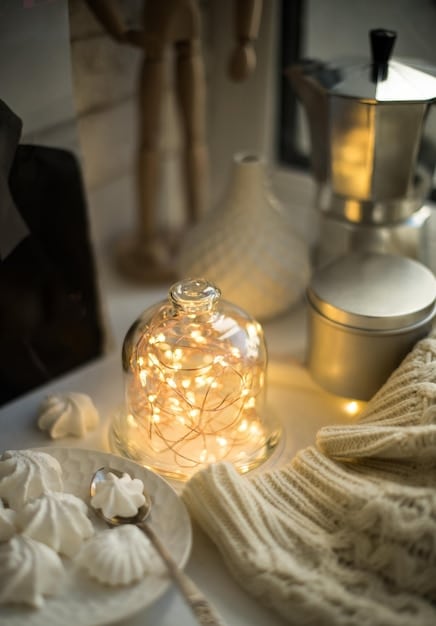
The layout of lights is also essential, think strategically where you are going to put them.
- Use Bedside Lamps: Provide convenient task lighting for reading in bed.
- Incorporate Wall Sconces: Save space on your nightstands and add a touch of elegance.
- Add a Ceiling Fan with a Light Kit: Provides both lighting and air circulation for added comfort.
By creating a soft and layered lighting scheme, you can transform your bedroom into a peaceful and relaxing retreat.
Bathroom Lighting: Functionality and Style
The bathroom requires a combination of functional and flattering lighting. Proper lighting is essential for tasks like grooming, applying makeup, and shaving.
Achieving Flattering Bathroom Lighting
Start with ambient lighting, such as recessed lighting or a ceiling fixture. Add task lighting with sconces or vertical light bars on either side of the mirror. Avoid overhead lighting, which can cast unflattering shadows on the face.
Choose light bulbs that mimic natural daylight for accurate color rendering. Consider using a dimmer switch to adjust the brightness depending on the time of day.
Think about adding a decorative pendant light over the bath for a more stylish statement. This can enhance the overall look and feel of the room.
With the correct combination, you can improve the appearance of you and your room. Don’t forget to always think ahead.
Things to consider for good lighting
Consider a mirror with integrated LED lighting for a modern and functional touch. This can eliminate the need for additional sconces and provide even and flattering illumination.
Proper lighting is so important and can make a big difference in the functionality and usability of your bathroom. Plan your lighting scheme carefully to ensure that it meets your needs and enhances the overall design.
Home Office Lighting: Productivity and Focus
The home office requires bright and focused lighting to promote productivity and concentration. Proper lighting can reduce eye strain and fatigue, making it easier to work for long periods.
Optimizing Lighting for Productivity
Start with bright ambient lighting, such as recessed lighting or a ceiling fixture. Add task lighting with a desk lamp that can be adjusted to provide focused illumination. Consider using a monitor light bar to reduce glare on your computer screen.
Choose light bulbs with a cool white color temperature for optimal focus and alertness. Avoid warm light, which can be too relaxing and make you feel sleepy.
Ensure that your lighting is evenly distributed to avoid shadows and glare. Position your desk lamp to minimize reflections on your computer screen.
- Adjustable Desk Lamp: Provides focused illumination for reading and writing.
- Monitor Light Bar: Reduces glare and eye strain while working on the computer.
- Natural Light: Position your desk near a window to take advantage of natural light whenever possible.
By optimizing your lighting for productivity, you can create a comfortable and efficient work environment.
Dining Room Lighting: Setting the Mood
The dining room is a place for meals and conversation. The lighting should aim for both functionality and be appropriate for socializing.
Tips for a perfect dining room
Consider a chandelier, for a style statement or a pendant light fixture centered over the dining table. Use a dimmer switch to adjust the brightness depending on the occasion. Add accent lighting with wall sconces to create a warm and inviting atmosphere.
Remember that the choice is all about balance. There needs to be sufficient light, without it becoming to intense.
It is also important to make the room feel comfortable and have you not constantly thinking about the light. This means finding ones, that will enhance the look and feel of your dining room, not detract from it.
Use candles or dimmable lights to set a relaxed mood. This is a simple way of reducing eye-strain, and will let other objects become visible.
| Key Point | Brief Description |
|---|---|
| 💡 Layering Lighting | Combine ambient, task, and accent lighting for optimal functionality. |
| 🌡️ Color Temperature | Choose warm lighting for bedrooms and cool lighting for kitchens and home offices. |
| 💡 Room-Specific Needs | Adjust lighting based on the activities and functions performed in each room. |
| 💡 Dimmers | Use dimmer switches to adjust the brightness and set the mood in different rooms. |
FAQ
▼
The three main types of lighting are ambient, task, and accent lighting. Ambient lighting provides overall illumination, task lighting focuses on specific tasks, and accent lighting highlights particular objects or areas.
▼
Choose warmer color temperatures (2700-3000K) for relaxing spaces like bedrooms and living rooms. Cooler color temperatures (3500-5000K) are better for task-oriented areas like kitchens and home offices.
▼
The best way to light a bathroom mirror is to use sconces or vertical light bars on either side of the mirror. This provides even and flattering illumination for grooming and makeup application.
▼
To create a cozy atmosphere in your living room, use warm light bulbs, incorporate dimmer switches, and layer different types of lighting. Add table lamps, floor lamps, and accent lighting to highlight focal points.
▼
Task lighting is important in the kitchen because it provides focused illumination for cooking, cleaning, and other tasks performed on countertops and work surfaces. Under-cabinet lights are a great way to achieve this.
Conclusion
Choosing the right lighting for your home involves understanding the specific needs of each room and how different types of lighting can work together to create the desired ambiance and functionality. By following these tips, you can transform your home into a well-lit and inviting space.



